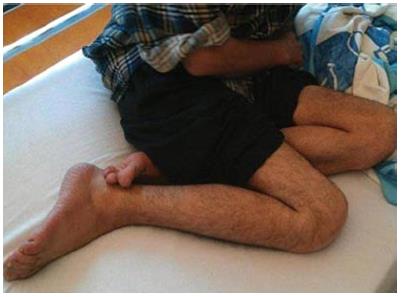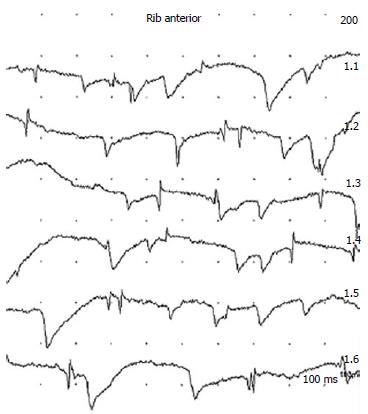Published online Feb 16, 2014. doi: 10.12998/wjcc.v2.i2.39
Revised: December 18, 2013
Accepted: January 15, 2014
Published online: February 16, 2014
Processing time: 260 Days and 19.7 Hours
A 51-year-old man presented to our hospital with progressive pain and weakness in his right leg. Neurological examination revealed atrophy of all muscles of the right leg, unilateral foot drop and paralysis of the anterior tibial and gastrocnemicus muscles. Electromyography confirmed a severe isolated sciatic neuropathy in the thigh. For unclear reasons, our patient habitually used to sit in a modified lotus position. We concluded that this position, in literature known as “lotus neuropathy” had resulted in the sciatic neuropathy. After more than a year our patient was referred again to our outpatient clinic. At that time there was only minimal improvement, now with an achilles tendon contracture and pes equinus due to immobility.
Core tip: In this case history we report on a patient with a severe isolated sciatic neuropathy with a foot drop, a complication of prolonged sitting in a modified lotus position. Although rare, similar reports of sciatic nerve injury due to external compression as a result of prolonged or repeated sitting in the same position have been reported. A so-called “lotus neuropathy” should be included in the differential diagnosis in patients presenting with a isolated sciatic neuropathy.
- Citation: Bosma JW, Wijntjes J, Hilgevoord TA, Veenstra J. Severe isolated sciatic neuropathy due to a modified lotus position. World J Clin Cases 2014; 2(2): 39-41
- URL: https://www.wjgnet.com/2307-8960/full/v2/i2/39.htm
- DOI: https://dx.doi.org/10.12998/wjcc.v2.i2.39
Isolated sciatic nerve injury is a common clinical situation. Several mechanisms are responsible for sciatic neuropathies. In this case report we describe a patient with complete paralysis of the right leg due to prolonged sitting in a modified lotus position.
A 51-year-old male fugitive from Iran with post-traumatic stress disorder and schizophrenia presented to our hospital with progressive pain and weakness in the right lower extremity and with difficulty in walking. The symptoms had been present for 6 mo and there was no history of a trauma. The patient denied back pain, bowel or bladder incontinence or sexual dysfunction. He drank alcohol occasionally.
General physical examination was unremarkable. Neurological examination demonstrated atrophy of all muscles of the right lower extremity. He ambulated with a steppage gait associated with an unilateral foot drop and ankle instability. Patient complained of dysesthetic pain, described as a constant burning sensation in the distal sciatic nerve distribution. Pinprick sensation was diminished in the distribution of the right peroneal nerve. The anterior tibial and gastrocnemicus muscles were paralysed (grade 0 MRC scale). Strength was normal in the more proximal sciatic innervated muscles. The right ankle reflex was absent.
His general practitioner mentioned that, for unclear reasons, our patient habitually used to sit in a modified lotus position (Figure 1). We hypothesized that repeated sitting in this position, with the right thigh on the heel of the left foot, had lead to compression and subsequent injury of the right sciatic nerve. Magnetic resonance imaging of the spine was normal. Electromyography and nerve conduction studies confirmed a severe isolated sciatic neuropathy in the thigh of the right lower extremity (Figure 2).
The causes of sciatic mononeuropathy can be divided into those occurring in the hip and the thigh region. Only the minority of sciatic neuropathies are localised in the thigh and several mechanisms can lead to sciatic nerve damage in this region[1]. Most frequently the nerve injury is the result of a femur fracture, posterior thigh compartment syndrome, laceration, nerve infarction, mass lesions or acute external compression. Prolonged external compression of the sciatic nerve results in nerve damage from ischemia or from direct mechanical laceration of the nerve.
In literature similar cases with development of sciatic nerve injury due to external compression as a result of prolonged or repeated sitting in the same position have been reported. Sciatic neuropathy occurring as an intra-operative pressure palsy is a well-known complication of surgery[2]. “Toilet seat” sciatic neuropathy as a complication of gluteal compartment syndrome has been reported in alcoholic intoxicated people falling asleep on a toilet[3]. Furthermore, injury of the sciatic nerve after yoga meditation is a known entity, called “lotus neuropathy”[4,5].
Our patient was managed conservatively and subsequently failed to follow up after discharge, but was finally referred again to our outpatient department after more than a year. At that moment there was a minimal improvement of neurologic function of the leg. Additionally, an achilles tendon contracture and pes equinus had developed due to immobility.
In conclusion, in this paper we report a patient with an isolated sciatic neuropathy due to compression of the thigh as a result of sitting in a modified lotus position.
This patient complained of progressive pain and a 6-mo history of weakness in the right lower extremity and with difficulty in walking.
Further examination revealed a complete and isolated sciatic neuropathy due to compression of the thigh as a result of sitting in a modified lotus position.
The differential diagnostic considerations were nerve injury as a result of a femur fracture, posterior thigh compartment syndrome, laceration, nerve infarction, mass lesions or acute external compression.
Magnetic resonance imaging of the spine was normal. Electromyography and nerve conduction studies confirmed a severe isolated sciatic neuropathy in the thigh of the right lower extremity.
The patient was managed conservatively and referred to a physiotherapist, but subsequently failed to follow up.
“Lotus neuropathy” is an entity due to injury of the sciatic nerve after yoga meditation.
Although rare, a so-called “lotus neuropathy” should be included in the differential diagnosis in patients presenting with a isolated sciatic neuropathy.
The authors report an interesting clinical case with a novel clinical entity. Presentation is extremely clear.
P- Reviewers: Hadianamrei R, Maheshwari AV, Posadas EM S- Editor: Ma YJ L- Editor: A E- Editor: Wu HL
| 1. | Yuen EC, So YT, Olney RK. The electrophysiologic features of sciatic neuropathy in 100 patients. Muscle Nerve. 1995;18:414-420. [RCA] [PubMed] [DOI] [Full Text] [Cited by in Crossref: 54] [Cited by in RCA: 45] [Article Influence: 1.5] [Reference Citation Analysis (0)] |
| 2. | Stewart JD, Angus E, Gendron D. Sciatic neuropathies. Br Med J (Clin Res Ed). 1983;287:1108-1109. [RCA] [PubMed] [DOI] [Full Text] [Cited by in Crossref: 24] [Cited by in RCA: 24] [Article Influence: 0.6] [Reference Citation Analysis (0)] |
| 3. | Tyrrell PJ, Feher MD, Rossor MN. Sciatic nerve damage due to toilet seat entrapment: another Saturday night palsy. J Neurol Neurosurg Psychiatry. 1989;52:1113-1115. [RCA] [PubMed] [DOI] [Full Text] [Cited by in Crossref: 16] [Cited by in RCA: 18] [Article Influence: 0.5] [Reference Citation Analysis (0)] |
| 4. | Chusid J. Yoga foot drop. JAMA. 1971;217:827-828. [RCA] [PubMed] [DOI] [Full Text] [Cited by in Crossref: 8] [Cited by in RCA: 8] [Article Influence: 0.1] [Reference Citation Analysis (0)] |
| 5. | Vogel CM, Albin R, Alberts JW. Lotus footdrop: sciatic neuropathy in the thigh. Neurology. 1991;41:605-606. [RCA] [PubMed] [DOI] [Full Text] [Cited by in Crossref: 18] [Cited by in RCA: 13] [Article Influence: 0.4] [Reference Citation Analysis (0)] |










